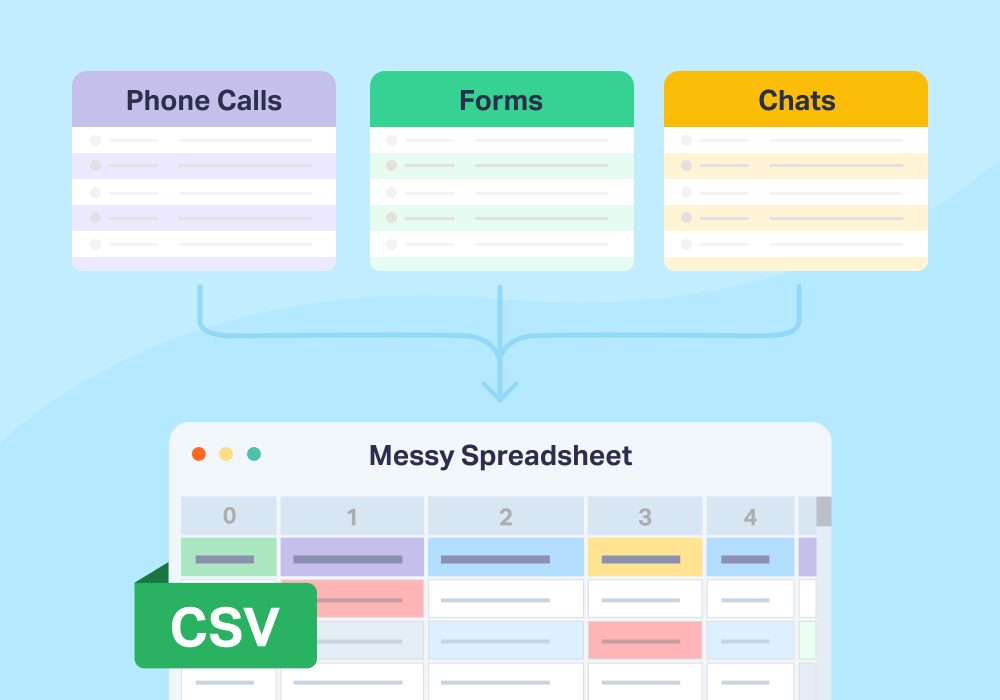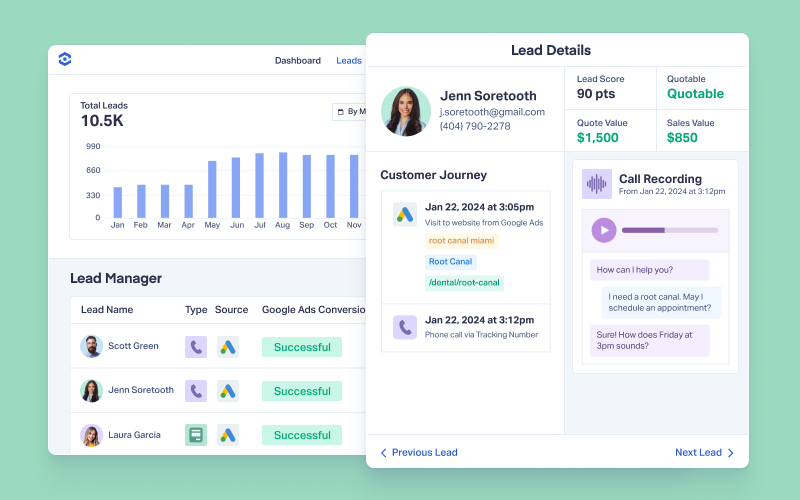
The Client Question Every Agency Fears
Your client calls:
“We spent $30,000 last month. What’s our ROI?”
You freeze.
Because the truth is… you don’t know. Not without logging into five different platforms, cross-checking spreadsheets, and praying you’re not double-counting leads.
That’s the fragmented data problem.
The Problem: Every Lead Type Lives in Its Own Silo
Here's what most agencies are dealing with:
- Call tracking lives in your call tracking platform
- Form submissions are captured in Google Analytics or HubSpot
- Live chat conversations exist in Zendesk or Intercom
- E-commerce transactions sit in Shopify or WooCommerce
- Attribution data is scattered across Google Ads, Meta Ads Manager, and analytics tools
Each platform does its job, but none of them talk to each other.
You have raw data everywhere, but none of it is available in a format that offers real insights into your overall performance.
The Pain Point in Action
A home services agency runs campaigns for a plumbing client. In one week, they drive:
- 45 phone calls (call tracking platform)
- 23 contact forms (Google Analytics)
- 12 live chats (Intercom)
- 8 online bookings (the client's scheduling software)
That's 88 leads. But which campaign drove which lead type? Which lead source generates the highest-value customers? The data exists, but it's locked in four separate systems.
The agency spends hours every week manually pulling reports, copying data into spreadsheets, and trying to build a coherent picture. By the time they finish, the data is already outdated.
Why Fragmentation Kills Performance
Fragmented data isn't just annoying; it actively prevents optimization.
Ad platforms can't optimize what they can't see. Google Ads might know about form fills, but not phone calls. It sees chat conversions, but not which chats turned into revenue. Without a complete view of all lead types, the algorithm optimizes for whatever partial data it has—which means it's guessing.
Agencies can't prove ROI across channels. When a client asks "Is our Facebook spend working?", you should be able to show exactly how many calls, forms, chats, and transactions Facebook drove, and what those leads were worth. Instead, you're saying "Well, Facebook drove 12 forms according to this dashboard, but I'd need to check CallRail for calls..."
Budget decisions happen in the dark. Should you shift more budget to search or social? Should you invest in chat software or focus on phone handling? You can't answer these questions confidently when each lead type lives in isolation.
From Fragmented to Unified
Here's how switching to a unified tracking platform unlocks better performance:
- Single Source of Truth: Instead of reconciling five different platforms, agencies work from one dashboard that captures every lead type.
- Complete Funnel Visibility: Different lead types perform differently at each funnel stage, which changes how you bid, where you send traffic, and what you optimize for.
- Faster Optimization Cycles: When all lead data lives in one place, you spot patterns immediately and shift your strategy accordingly, without having to spend hours compiling reports before you can make decisions.
- Accurate ROI Calculation: The math is simple when the data is unified—total leads across all types, divided by total ad spend, multiplied by average customer value.
Agency Impact Example
Avita Digital was an agency working with a luxury yacht event business drowning in fragmented data. The client ran outbound sales teams but couldn't identify which marketing channels actually drove bookings. Their custom CRM offered no real insight.
Before WhatConverts, lead sources were scattered across multiple systems with no way to track performance or value. After implementing WhatConverts, Avita Digital unified all inbound tracking—calls, forms, and campaigns—and segmented leads by event type with attached revenue values (weddings at $10k, corporate events at $25k).
As a result, they slashed cost-per-acquisition by over 50%, eliminated the entire outbound sales team, and optimized budgets toward campaigns generating the highest-value leads.
Read More: Avita Digital Drives 50%+ CPA Reduction & Major Operational Savings [Case Study]
Closing the Fragmentation Gap
Tracking multiple lead types shouldn't mean managing multiple dashboards. With unified lead tracking, agencies can:
- Capture all lead types (calls, forms, chats, transactions) in one platform
- See complete marketing attribution for every lead, regardless of type
- Compare performance across lead types and channels
- Report total ROI without manual data reconciliation
- Optimize campaigns based on complete conversion data, not fragments
The result: clients see the full picture of their marketing performance. Ad platforms get the complete conversion data they need to optimize. And agencies finally stop playing data detective just to answer basic questions.
When all your lead types live in one place, proving ROI becomes simple instead of impossible.
Ready to unify your lead data and stop juggling dashboards? Sign up for your free 14-day WhatConverts trial today and see all your calls, forms, chats, and transactions in one place—or book a demo to see how agencies are proving ROI across every lead type.
Get a FREE presentation of WhatConverts
One of our marketing experts will give you a full presentation of how WhatConverts can help you grow your business.
Schedule a Demo
Grow your business with WhatConverts






